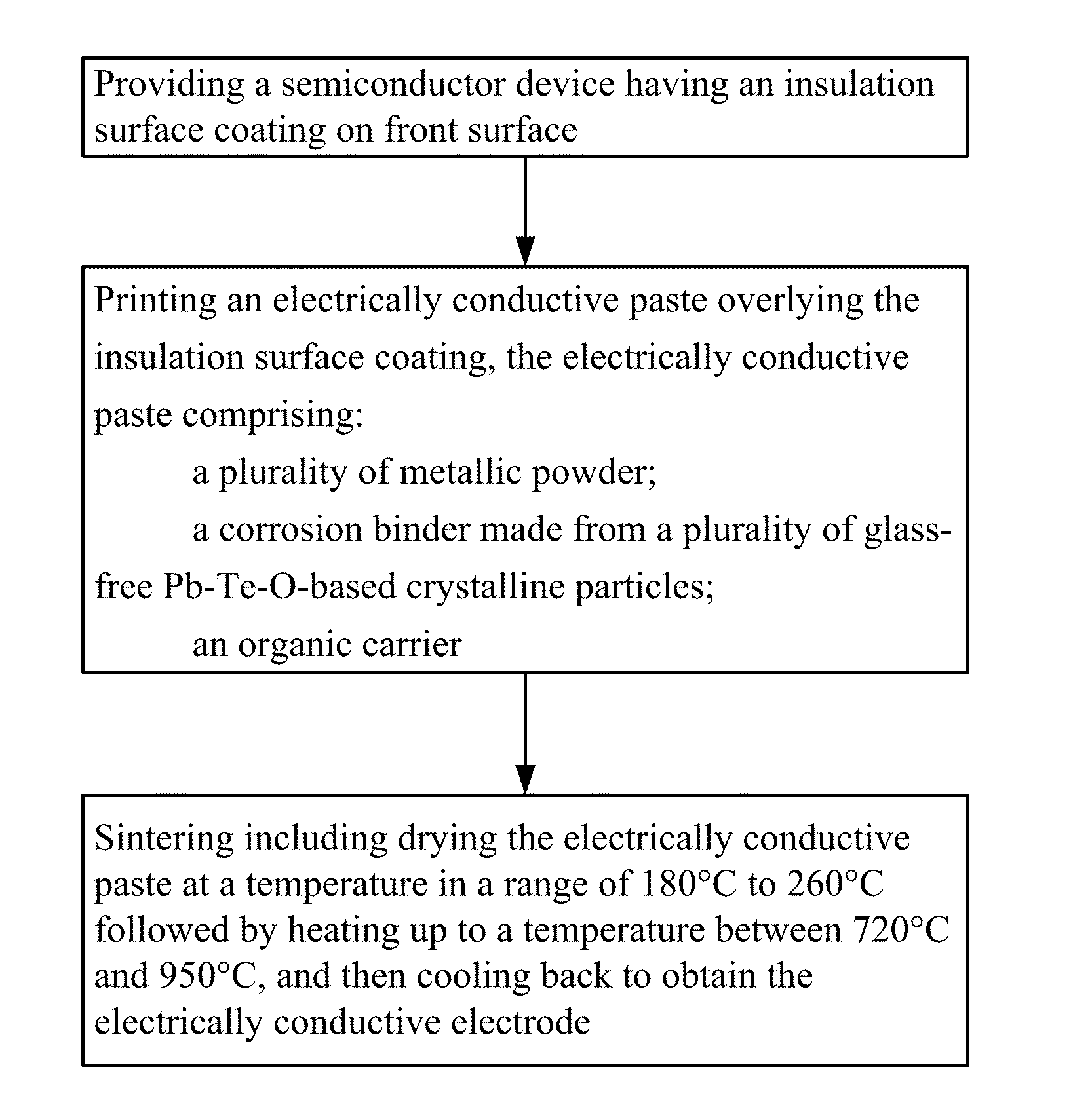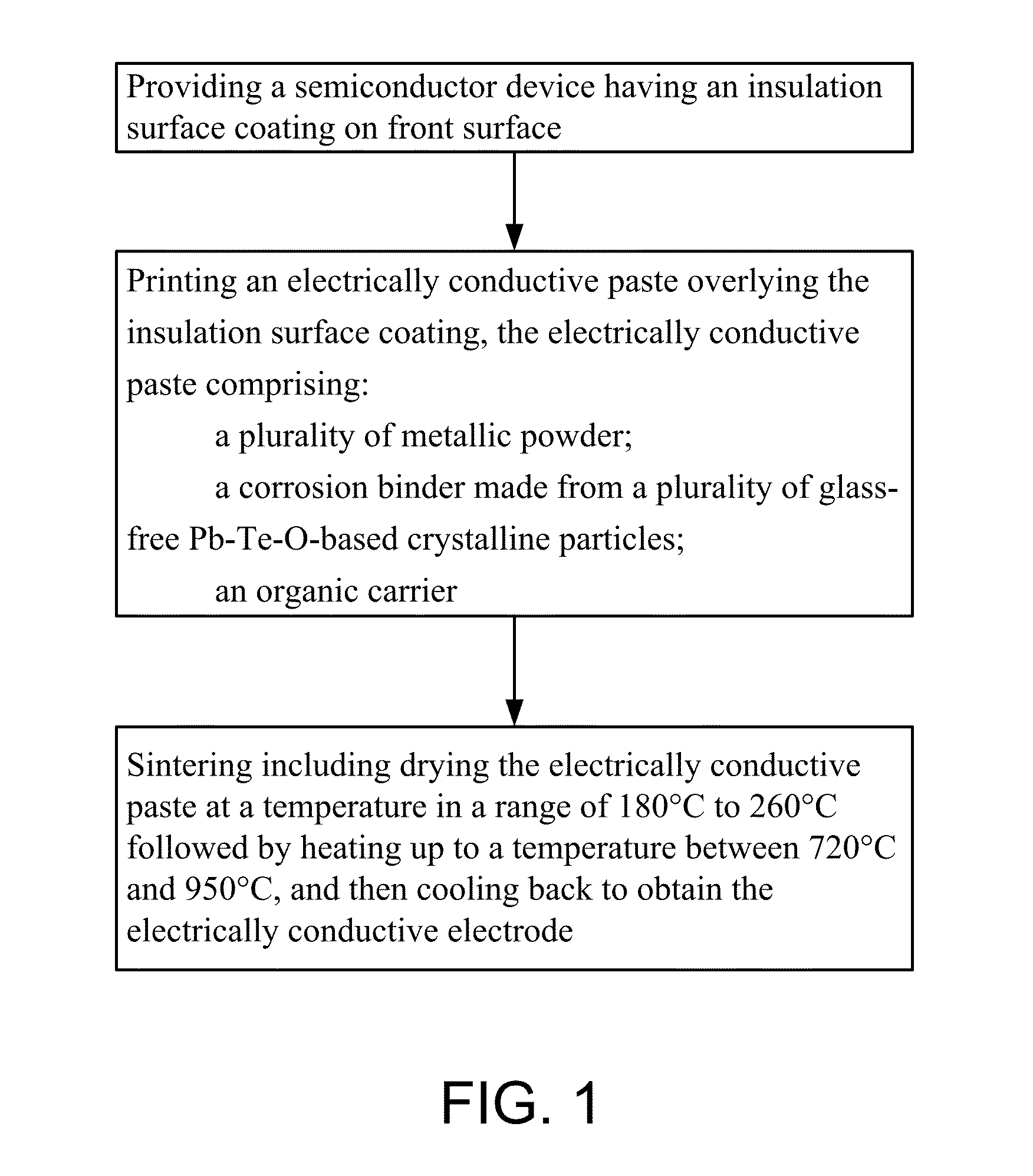Electrically conductive paste for front electrode of solar cell and preparation method thereof
a solar cell and front electrode technology, applied in the field of solar cells, can solve the problems of affecting the performance of the solar cell, and unable to ensure the full contact and complete reaction of glass frit and the anti-reflective layer, so as to achieve enhanced photovoltaic conversion efficiency and reduce the effect of series resistan
- Summary
- Abstract
- Description
- Claims
- Application Information
AI Technical Summary
Benefits of technology
Problems solved by technology
Method used
Image
Examples
embodiment 1
[0070]Based on the total weight of 100 parts, the electrically conductive paste for a front electrode of a solar cell contains: 8.3 parts of a corrosion binder, 81.7 parts of a metallic powder and 10 parts of an organic carrier. The corrosion binder is a PbTeO3 compound; the metallic powder is a silver powder, and the organic carrier includes, based on the total weight of 100 parts, 70 parts of a terpineol organic solvent, 14 parts of an ethyl cellulose binder, 10 parts of a wetting and dispersing agent, 5.5 parts of a thixotropic agent and 0.5 part of microcrystalline wax. Preparation of the corrosion binder includes: preparing a hot tellurous acid solution having a concentration of 0.1 mol / L and heating to 90° C., adding a lead acetate solution having a concentration of 0.1 mol / L in proportion (the molar ratio of tellurous acid to lead acetate being 1:1), heating the mixture solution for reaction, to obtain a precipitate of the PbTeO3 compound. The metallic powder is a silver powd...
embodiment 2
[0071]Based on the total weight of 100 parts, the electrically conductive paste for a front electrode of a solar cell contains: 7.3 parts of a corrosion binder, 81.7 parts of a metallic powder and 11 parts of an organic carrier. The corrosion binder is a Pb3TeO5 compound, the metallic powder is a silver-coated nickel powder, the organic carrier includes, based on the total weight of 100 parts, 50 parts of an alcohol ester-12 organic solvent, 40 parts of a polymethacrylate binder, 5 parts of a wetting and dispersing agent, 4 parts of a thixotropic agent and 1 part of DBP. Preparation of the corrosion binder includes: at a proportion of a molar ratio of PbO and TeO2 being 3:1, continuously introducing Pb3Te alloy vapor into a reaction chamber filled with oxygen atmosphere of 1,300° C., and inducing a chemical reaction, to obtain a powder of a Pb—Te—O-based crystalline compound deposited at the bottom of the chamber, and collecting a Pb3TeO5 compound. The metallic powder is prepared by...
embodiment 3
[0072]Based on the total weight of 100 parts, the electrically conductive paste for a front electrode of a solar cell contains: 8.8 parts of a corrosion binder, 80 parts of a metallic powder and 11.2 parts of an organic carrier. The corrosion binder is a PbTeCO5 compound, the metallic powder is silver-coated copper, and the organic carrier includes, based on the total weight of 100 parts, 65 parts of a terpineol organic solvent, 20 parts of an alkyd resin binder, 0.1 part of a wetting and dispersing agent, 2.5 parts of a thixotropic agent1 and 2.4 parts of PVB. Preparation of the corrosion binder includes: in CO2 atmosphere, placing PbO and TeO2 at a proportion of a molar ratio of being 1:1 in a high-temperature (1,200° C.) furnace, and reacting for 1 hour, naturally cooling the resulting product, and pulverizing and grinding, to obtain the PbTeCO5 compound. The metallic powder is a silver-coated copper powder, and is prepared by using a chemical plating method, including: plating s...
PUM
| Property | Measurement | Unit |
|---|---|---|
| melting temperature | aaaaa | aaaaa |
| melting temperature | aaaaa | aaaaa |
| temperature | aaaaa | aaaaa |
Abstract
Description
Claims
Application Information
 Login to View More
Login to View More - R&D
- Intellectual Property
- Life Sciences
- Materials
- Tech Scout
- Unparalleled Data Quality
- Higher Quality Content
- 60% Fewer Hallucinations
Browse by: Latest US Patents, China's latest patents, Technical Efficacy Thesaurus, Application Domain, Technology Topic, Popular Technical Reports.
© 2025 PatSnap. All rights reserved.Legal|Privacy policy|Modern Slavery Act Transparency Statement|Sitemap|About US| Contact US: help@patsnap.com



